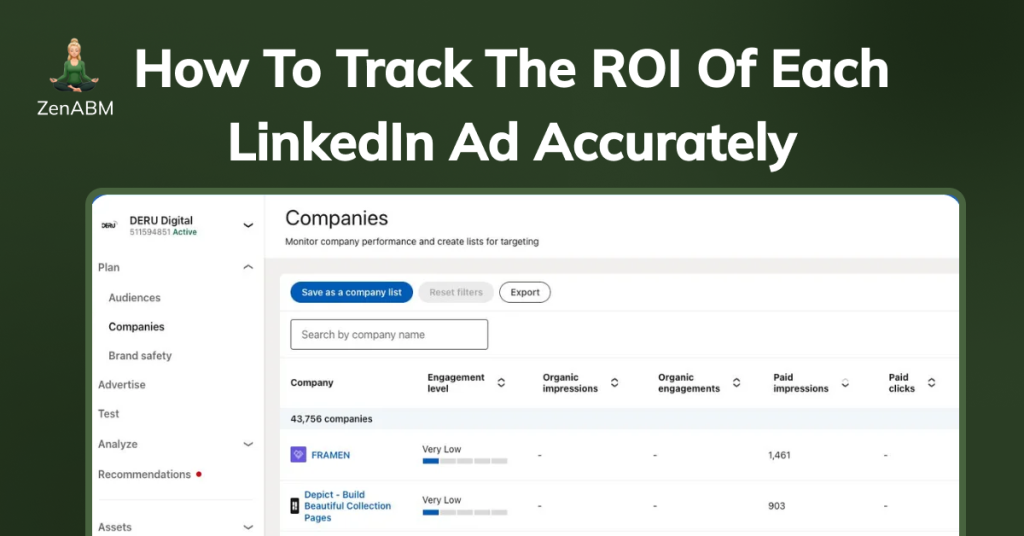LinkedIn ad ROI tracking is tricky business (hello, B2B and its buyer complex buyer journeys).
It’s difficult to credit specific LinkedIn ads with the revenue they influence, especially when conventional ROI tracking methods, like LinkedIn’s native solutions or the ones in your CRM, don’t help.
In this post, we’ll examine why conventional ROI tracking methods fall short on LinkedIn and the solution.
How to Track the ROI of Each LinkedIn Ad Accurately: Short Summary
- LinkedIn ad ROI tracking is broken because buyers rarely click ads, and most tools only track clicks.
- Why tracking fails:
- LinkedIn Campaign Manager: Tracks company-level impressions, but only at the ad account level. Doesn’t show which ad was seen by which company.
- Website deanonymization tools: Only work on clicks, 40% accuracy, fail with VPNs/shared IPs.
- Display ad networks: Rely on cookies and old behavioural data. Bot-heavy. Not future-proof.
- CRMs like HubSpot: Only capture data after a form fill. Miss view-through engagement entirely.
- What you actually need:
- Campaign-level, company-level engagement tracking (even if there’s no click).
- Multi-touch attribution across multiple campaigns, not just last-click.
- Direct integration with your CRM – so engagement shows up in real time.
- How ZenABM fixes this:
- Tracks every company that sees or engages with each LinkedIn ad – clicks not required.
- Shows engagement per campaign and per company.
- Syncs this data into CRMs like HubSpot as company properties.
- Provides real-time engagement scores to prioritize hot accounts.
- Tags campaigns by buyer intent and surface that insight to your BDRs.
- Links ad touchpoints to pipeline and revenue to calculate real ROI.
- Uses safe, first-party API data from LinkedIn – fully compliant.
- Bottom line: Click-based tools undervalue LinkedIn ads. ZenABM shows the real influence of your campaigns across the full buyer journey.
- Try ZenABM now and get accurate LinkedIn ad ROI tracking – finally.
Why LinkedIn Ad ROI Tracking Is Tricky (and Often Broken)
What makes tracking LinkedIn ad ROI so challenging?
For starters, LinkedIn is largely an awareness platform.
People don’t click here.
Just look at the CTR:
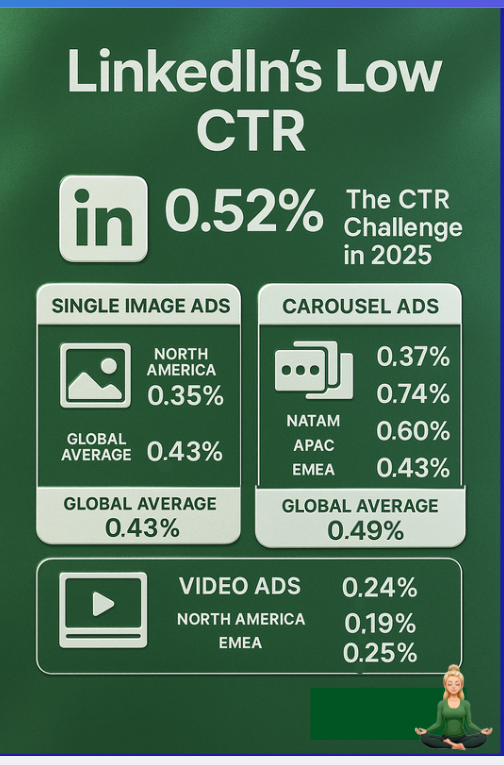
Unlike Google Search, where a user actively seeks something and clicks an ad with intent, on LinkedIn, your ideal buyers might just be scrolling their feed.
They could see your ad, become interested, but later Google your company or navigate directly to your site. You might then attribute that visit or conversion to SEO or direct traffic, completely missing LinkedIn’s influence.
Solution?
Don’t rely solely on a click-based tracking model. To truly track ROI, you need to capture the impact of view-through interactions – in other words, track impressions and engagement at the account level, not just clicks.
Many B2B marketers understand this in theory, but how to do it is another story. Conventional tools aren’t up to the task, for a variety of reasons:
LinkedIn Campaign Manager
LinkedIn’s own Campaign Manager has historically provided very limited insight into account-level engagement. It wasn’t until 2020 that they introduced the “Company Engagement Report,” and in late 2024, this evolved into the “Companies” tab:

This feature shows quite a lot of engagement data for companies like paid clicks and paid impressions (essentially taking you past the click-through tracking model).
But it doesn’t tie engagement to specific ads or campaigns. All the engagement metrics it shows are rolled up to the whole ad account.
So, yes, you’ll see company-level impressions and engagements, but you can’t see which individual ads the company saw.
Now, most marketers run several ABM campaigns at once, each branching into many campaign groups, with every group hosting numerous ad campaigns.
Those campaigns differ by:
- Ad format or creative
- Budget, schedule, owner, and frequency
- Buyer intent, i.e. the specific feature or benefit being promoted
Without campaign-level, company-specific data, you can’t map buyer intent or attribute revenue accurately.
Just look at the layered structure Userpilot uses, for example:
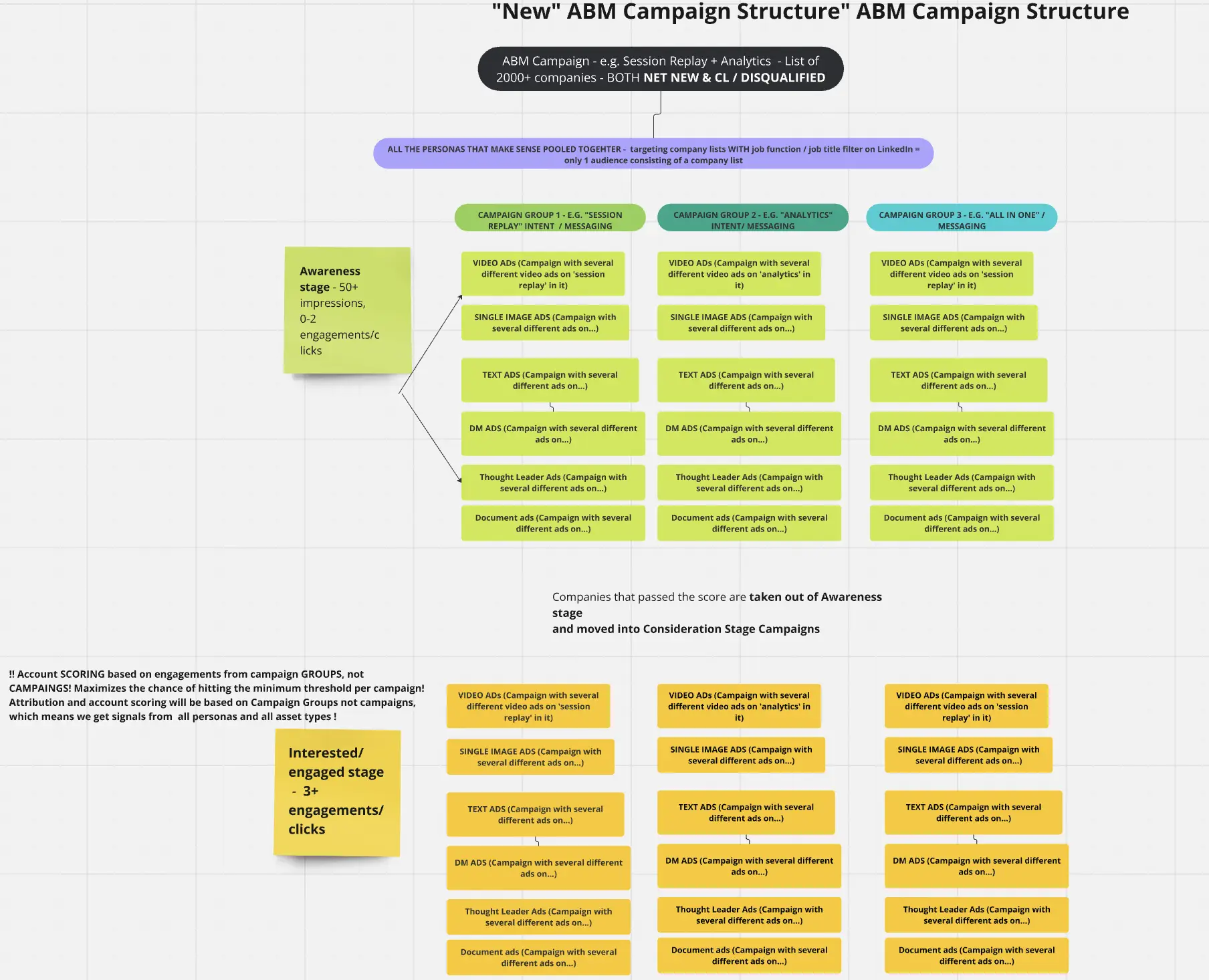
So, having engagement data lumped together at the ad account level is nearly useless. What you need is a breakdown of impressions, clicks, and engagement by company for each individual campaign, campaign group, and ABM campaign.
Without knowing the campaign-level breakdown of company-level engagement, you cannot track the ROI of each ad campaign/campaign group. You can never know which ads worked great and which didn’t. You cannot do real A/B testing either.
Website Deanonymization Tools
What about third-party tools that claim to reveal which companies visit your website?
These website deanonymization (wrap-ups for reverse IP tracking services) can identify some visitors’ companies by matching their IP addresses.
However, they only work when someone actually clicks your ad and lands on your site. This approach fails to track those who saw the ad but didn’t click – a huge blind spot for LinkedIn ads.
Even for the visitors who do click through, these tools are often disappointingly inaccurate (around 40% accuracy at best, according to a study by Syft:
Why?
Because IP matching is unreliable: if a visitor uses a VPN or a shared network (think of someone working from a coffee shop), the IP address won’t correctly map to their company.
And not to mention, most companies don’t even register their own IP addresses, so there’s nothing to match against:

A real-world example: one B2B company (Userpilot) tried using Clearbit which is touted as one of the more “accurate” IP tracking tools to identify companies visiting their site from LinkedIn ads.
The result?
The tool managed to reveal just one company, and it was their own (essentially, they only identified themselves):
The traditional deanonymization, in this example, barely moved the needle for LinkedIn ad ROI tracking.
Display Ad Networks & Behavioural Data Matching
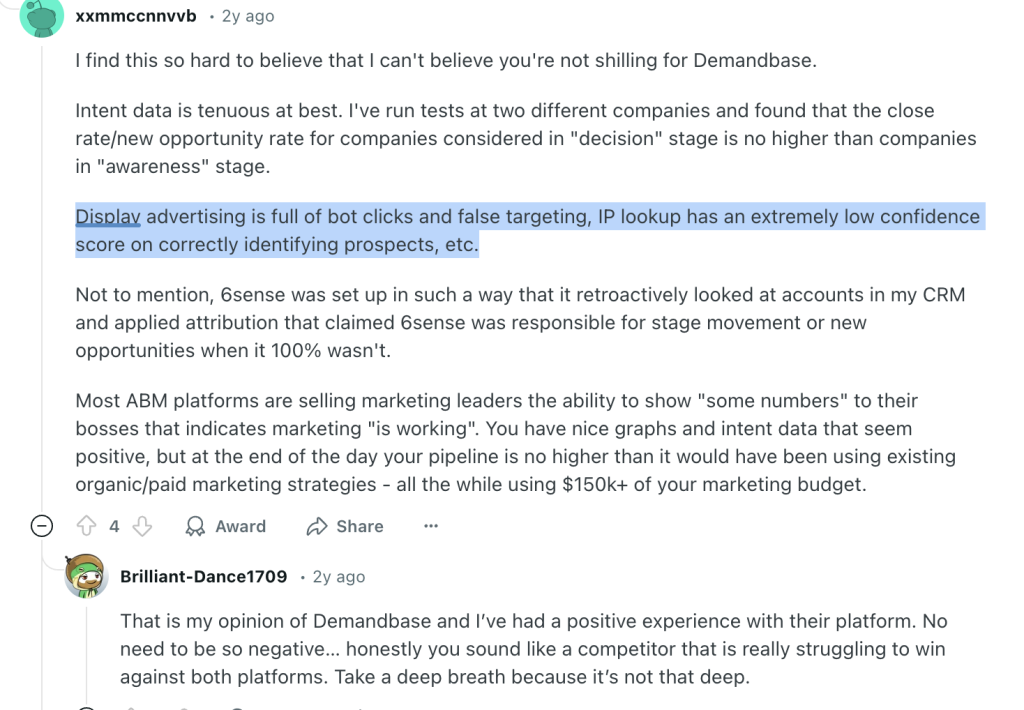
Some marketers turn to display ad networks (like AdRoll, Criteo, and others), hoping to glean LinkedIn insights by retargeting and matching audiences. These networks use methods like third-party cookies and device fingerprinting to follow people around and infer their company or industry from data platforms. Unfortunately, this doesn’t solve the LinkedIn ROI tracking puzzle either:
- Third-party cookies are on their way out (Google is finally phasing them out for Chrome – suddenly concerned about our privacy, perhaps?). If your tracking relies on cookies that will soon be obsolete, it’s not a future-proof strategy.
- Behavioural profiles can be outdated. For example, if someone changed jobs last month, a Data Platform might still associate them with their previous company, misleading your attribution.
- Display networks are rife with bots that mimic human behaviour. Fake clicks and views can inflate your engagement numbers. That means nearly a quarter of what looks like ad engagement could be anything but real prospects.
LinkedIn Ads CRM Integration
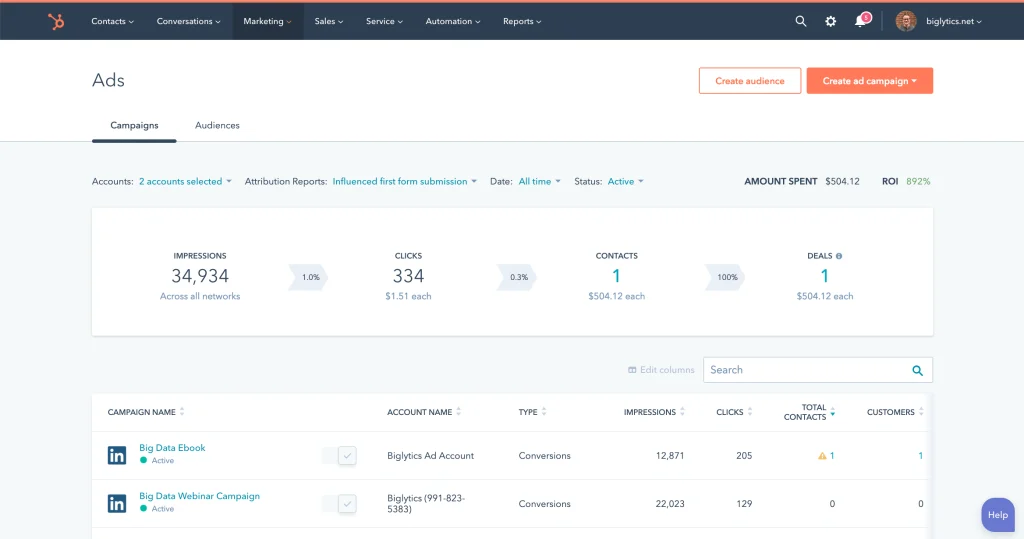
Another common approach is using your marketing automation or CRM platform’s ad integration – for example, HubSpot’s LinkedIn Ads integration.
HubSpot’s ads tool lets you connect your LinkedIn Ads account, sync lead form submissions, and even manage campaigns from within HubSpot. But when it comes to ROI tracking, it won’t tell you:
- Which companies saw each of your LinkedIn ads (only individual contacts, if they convert).
- Which companies clicked an ad but didn’t fill out a form (or clicked and later converted through a different channel).
- Which target accounts are repeatedly engaging with your ads over time (showing increasing interest).
- How your LinkedIn campaigns influence downstream opportunities and deals in your CRM.
You might ask, “Doesn’t HubSpot’s tracking script or the LinkedIn Insight Tag capture some of that?” The reality is, there are still big limitations:
- If a visitor converts on your site without providing their company name (common on generic demo forms), you won’t know which account they belong to.
- If someone from an account clicks an ad but only fills out a form later (or via a different device), cookie-based attribution might fail to link that back to the ad click.
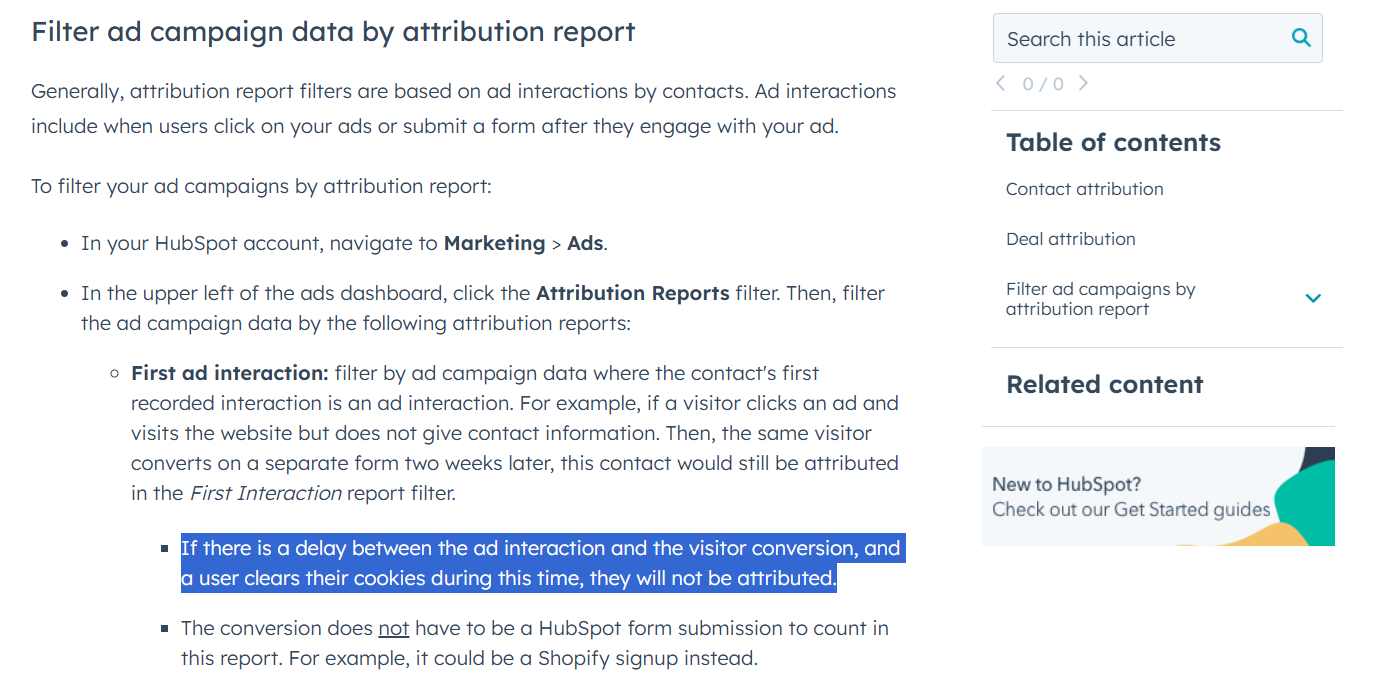
Source: HubSpot Knowledge Base - And of course, you’ll miss all influence on leads who never clicked at all. In B2B buying committees, it’s common that one person might click an ad but someone else from the company makes the inquiry, or multiple people see your ads and nobody clicks – yet those impressions collectively drive brand awareness. Remember, it’s B2B: influence often extends beyond a single click or person.
Bottom line(s)?
- CRMs like HubSpot are limited to click-through tracking and also need an immediate form fill. Same goes for LinkedIn CAPI and the Insight Tag.
- IP matching goes a bit further to eliminate the need of a form fill, but only in theory. It’s 40% accurate at best and the narrow approach of click-through tracking still remains.
- LinkedIn Campaign Manager’s ‘Companies’ tab gives view-through engagement tracking with company-level paid impression tracking. But it rolls up these paid impressions to the whole ad account. You still don’t know which company saw exactly which ad/ads and so can’t track the ROI of each ad campaign/campaign group.
What you need for true LinkedIn ad ROI tracking is a tool that tracks company-level ad engagement (even impressions, not just clicks) for each ad campaign/campaign group.
How ZenABM Enables Accurate LinkedIn Ad ROI Tracking

ZenABM uses LinkedIn’s official APIs to pull in rich, account-level engagement data for your campaigns—no guessing games, no browser cookies, no reverse IP lookups.
It’s a first-party approach to capturing what really happens with your LinkedIn ads. Here’s how ZenABM makes tracking LinkedIn ad ROI (and attributing it) a breeze:
Tracks Every Company That Sees or Engages with Your Ads
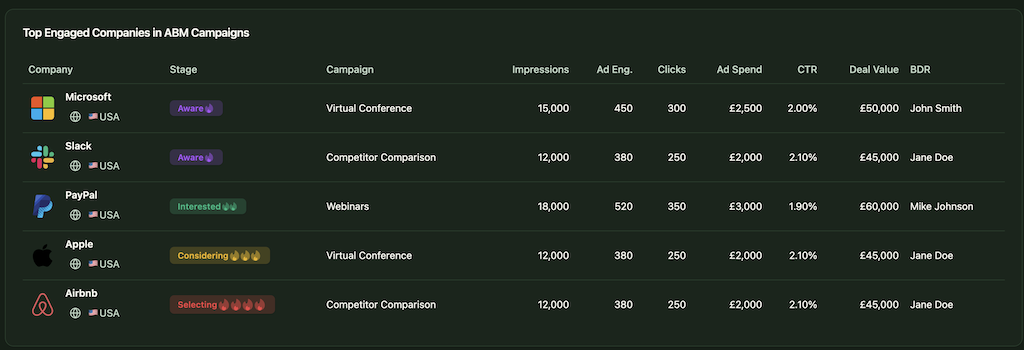
Whether a target account clicks or not, ZenABM will log their engagement. It captures every company that:
- Sees your ad (impression)
- Engages with your ad (e.g. a like, comment, or share)
- Clicks through on the ad
- Views the ad but never lands on your website
This means you can attribute influence even when there’s no immediate form-fill or click conversion. For example, let’s say Company X saw your LinkedIn ad 50+ times but never clicked. Later, someone from Company X comes to your website and fills out a demo request (perhaps by Googling you).
With ZenABM, you’ll know that those ad impressions played a role in planting the seed for that visit. And if multiple ads were shown to that account over time, you’ll see each one that contributed to warming them up. In short, ZenABM supports true “view-through” attribution for your LinkedIn campaigns, not just last-click attribution.
Gives Fair Attribution Across Campaigns
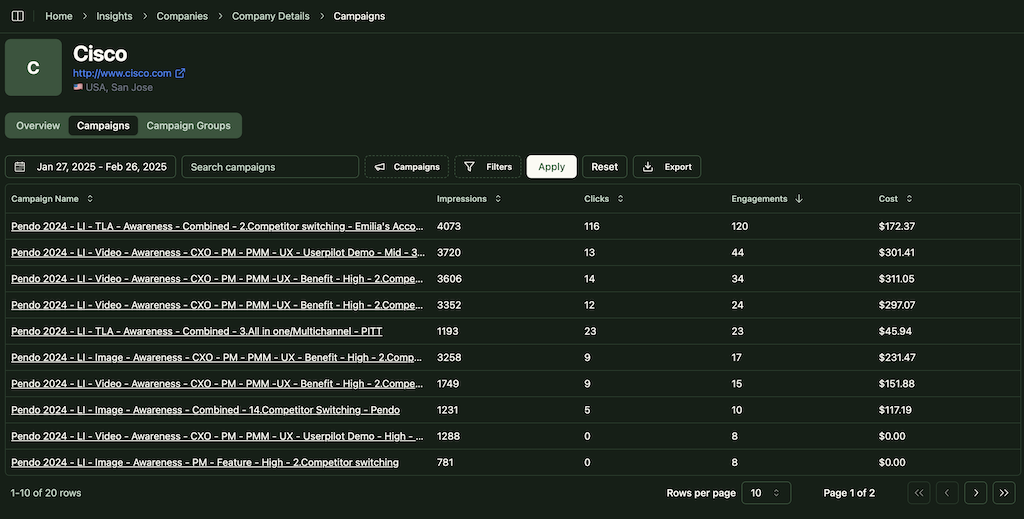
Often, marketers default to giving all credit to whichever ad was last clicked before a lead converted. Or they might overvalue the campaign that delivered the most clicks.
ZenABM takes a more balanced approach: it shows you all the LinkedIn campaigns an account interacted with on the path to becoming a customer, so you can spread the ROI credit fairly.
Maybe a prospect first engaged with a thought-leadership ad, later clicked a product-focused ad, and finally converted after a demo-offer ad – you’ll see each campaign’s engagement. This way, even smaller campaigns or early-stage ads get the credit they deserve for influencing the pipeline, instead of being overlooked.
Pushes Engagement Data into HubSpot Automatically
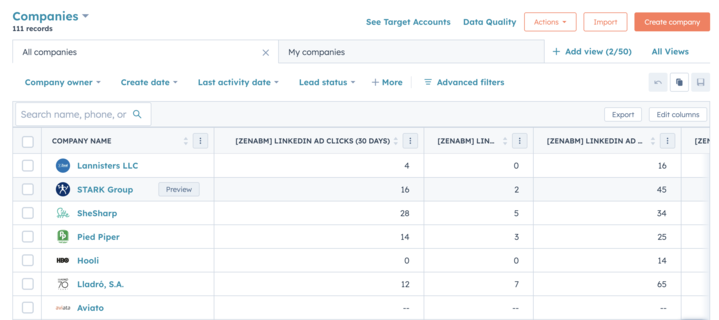
Don’t have time to manually crunch numbers or update spreadsheets?
ZenABM automates it. It pushes LinkedIn ad engagement data directly into your CRM (like HubSpot) as company-level properties. For example, you’ll get fields such as “LinkedIn Ad Impressions – Last 7 Days” and “LinkedIn Ad Clicks – Last 7 Days” for each account, updated continuously. These let you report on and trigger actions based on recent ad engagement.
Automates Lead Scoring and BDR Assignment and Identifies Buyer Intent

Another powerful feature of ZenABM is built-in lead scoring.
The platform calculates a real-time engagement score for each account based on factors like how many ads they’ve seen, how many times they clicked or interacted, and how recently these interactions happened. This “LinkedIn Engagement Score” acts as a proxy for intent – if an account is surging in engagement, it could be showing buying signals.
ALso, ZenABM can automatically use these scores to flag hot accounts to your sales team.
For instance, when an account’s score crosses a certain threshold, ZenABM can assign that company to a BDR in your CRM:

Buyer Intent Tracking and Syncing into the CRM
In ZenABM, you can tag every campaign or group with its underlying intent (feature, use-case, pain-point).
Then ZenABM will cluster engaged companies with that intent, so BDRs can talk about what prospects actually care about.
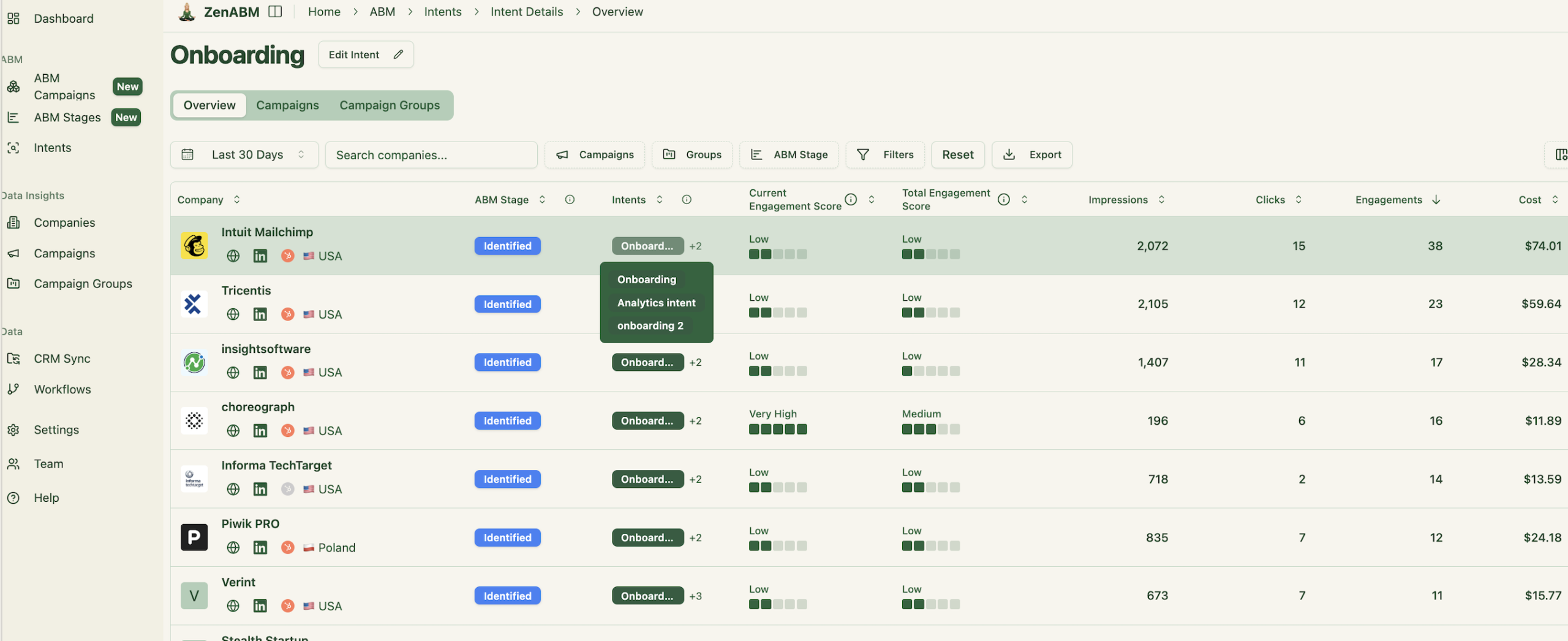
Connects LinkedIn Ads to Real Pipeline & Revenue

At the end of the day, tracking ROI is about connecting the ad spend to revenue outcomes.
ZenABM closes this loop by mapping LinkedIn ad engagement data to your pipeline in the CRM. It matches accounts (and even specific opportunities) that engaged with your ads to any deals those accounts have in progress or won. The result is a clear line of sight from ad campaigns to dollars.
Provides Plug-and-Play ABM Dashboards

Because ZenABM is built for account-based marketing, it comes with out-of-the-box dashboards to visualise all these metrics. You don’t have to be a data scientist or build custom reports to understand your LinkedIn ad performance. The platform gives you ready-made ABM dashboards that highlight the metrics that matter for ROI: impressions vs. engagement, pipeline influenced, ROI/ROAS, top engaged accounts, and more.
Effectively, ZenABM lets you shift from the old click-centric view of LinkedIn ads to an account-centric, ROI-centric view.
Uses Safe, First-Party Data (No Scraping)
Lastly, it’s important to note that ZenABM’s approach is fully sanctioned by LinkedIn. In recent times, LinkedIn has aggressively cracked down on unauthorized scraping tools:
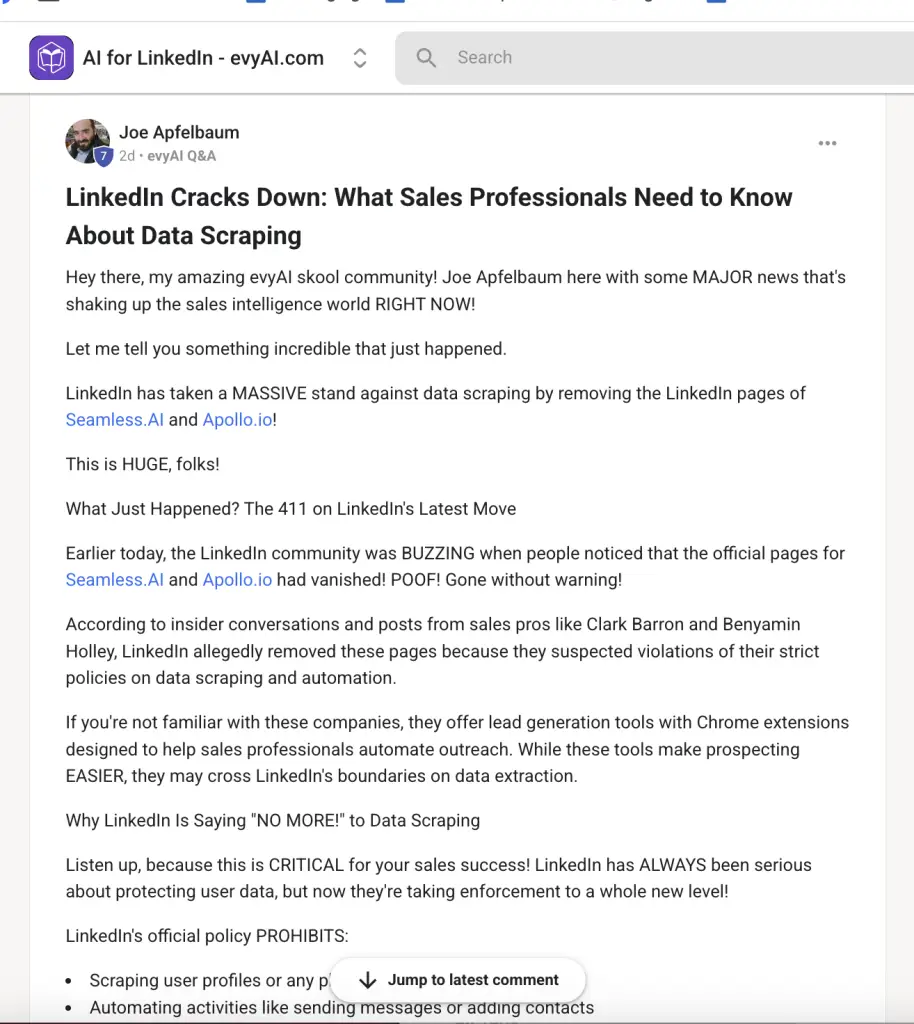
And even automation bots:
![]()
With ZenABM, you’re on the safe side – it pulls data via LinkedIn’s official API, adhering to the platform’s rules. You get the rich data and insights without any risk to your LinkedIn account or data compliance. It’s first-party, reliable data straight from the source.
Over to You
LinkedIn ad ROI tracking isn’t just about tallying clicks or form fills – it’s about understanding the full buyer journey from the first impression to the closed deal. Especially in B2B, where multiple touchpoints and long sales cycles are common, traditional “last click” models fall short. They simply overlook the influence that earlier ad impressions and engagements have on eventually converting a customer.
By shifting to an account-level tracking mindset, you can capture those hidden ROI drivers. ZenABM is one solution that makes this shift achievable by providing the data and tools to see which ads truly drive awareness, engagement, and revenue within your target accounts. When you know which campaigns actually move the needle (and not just which ads got a click), you can optimize your LinkedIn strategy for what really works.
Ready to stop guessing and start measuring what truly works?
Try ZenABM now and finally get the ROI clarity your LinkedIn ads deserve.

